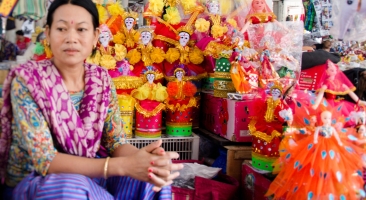‘If you do not put your laiphadibi back in the lubak (bamboo basket) after playing, they will cry at night under the banana plants.’ That was one scary imagery for child in a Manipuri household. Elders would use this imagery generously each time children would leave behind their dolls scattered after a play session. The Manipuri word for doll is Laiphadibi—‘lai’ meaning god and ‘phadi’ meaning shabby piece of cloth; the last syllabi ‘bi’ denoting feminine gender. So Laiphadibi or doll is a feminine image of god made from shabby clothes. From being a play thing to being an integral part of rituals, these dolls, popularly called laidhibi, are treated as living spirits.
This module introduces the readers to the traditional cloth dolls of the Meitei people of Manipur—how they are made, their importance in the society, the changes that came about due to the flooding of affordable Disney-inspired dolls in the local markets and the challenges faced by the doll makers. Since written documentation on laidhibi is very limited, the research was majorly dependent on interviews and interactions with craftpersons and doll sellers, and historians and senior members of the community.

